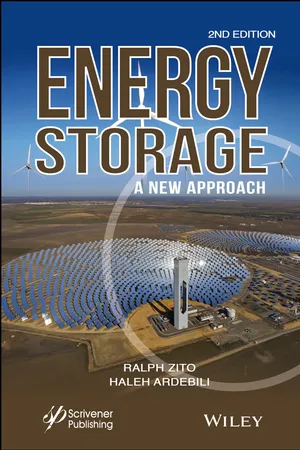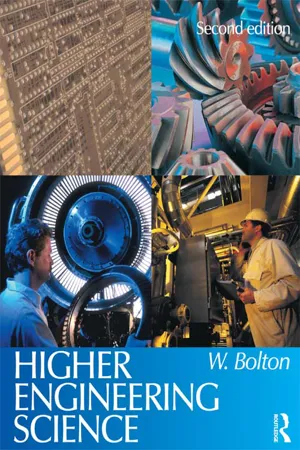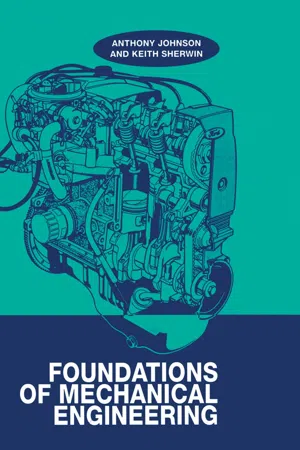Energy in Mechanics
Energy in mechanics refers to the capacity of a physical system to do work. It can exist in various forms such as kinetic energy (energy of motion) and potential energy (stored energy). In mechanical systems, energy is conserved, meaning it can change from one form to another but cannot be created or destroyed.
6 Key excerpts on "Energy in Mechanics"
- eBook - ePub
Energy Storage
A New Approach
- Ralph Zito, Haleh Ardebili(Authors)
- 2019(Publication Date)
- Wiley-Scrivener(Publisher)
...Even the concept of straight lines is rather intuitive in nature. Perhaps the best definition is that a force is required to change the motion of a body. Many problems arise in finding acceptable definitions for the basic parameters of physical science, namely, the abstract concepts of mass, time, force, and energy. However, we must learn to be satisfied with definitions that leave something to be desired in order to move on toward generating a working body of mechanics that enables us to design and build practical devices that serve our purposes. An interesting definition of energy comes from the Grolier Encyclopedia, which states: Energy can be measured in terms of mechanical work, but because not all forms of energy can be converted into useful work, it is more precise to say that the energy of a system changes by an amount equal to the net work done on the system … In classical physics, energy, like work, is considered a scalar quantity; the units of energy are the same as those of work. These units may be ergs, joules, watt-hours, foot-pounds, or foot-poundals, depending on the system of units being used. In modern science, energy and the three components of linear momentum are thought of as different aspects of a single four-dimensional vector quantity, much as time is considered to be one aspect of the four-dimensional space-time continuum … Energy exists in many different forms. The form that bodies in motion possess is called kinetic energy. Energy may be stored in the form of potential energy, as it is in a compressed spring. Chemical systems possess internal energy, which can be converted by various devices into useful work; for example, a fuel such as gasoline can be burned in an engine to propel a vehicle. Heat energy may be absorbed or released when the internal energy of a system changes while work is done on or by the system...
- W. David Yates(Author)
- 2020(Publication Date)
- CRC Press(Publisher)
...15 Mechanics In this chapter, we will discuss and review the equations listed on the Board of Certified Safety Professionals (BCSP) examination reference sheet 1 related to mechanics. Our primary focus will be on the equations related to energy, work, force, and velocity. Mechanics can be defined as the study of the relationships between motion, forces, and energy. As a safety professional, you must have a thorough working knowledge of this science in order to adequately perform the basic responsibilities of your position. Energy We will discuss two types of energy in this chapter, potential energy and kinetic energy. The laws of energy are as follows: The first law of thermodynamics says that energy under normal conditions cannot be created or destroyed, simply transformed from one type of energy to another (also known as the law of conservation); The second law of thermodynamics is a bit more complex than the first law, but basically states that any time you do work, including any time you make an energy transformation, some of the starting energy is going to be lost as heat. Kinetic Energy Kinetic energy is the energy of motion. An object that has motion, whether it be vertical or horizontal motion, has kinetic energy. There are many forms of kinetic energy, which include vibrational, rotational, and translational (energy due to motion from one location to another). The basic equation to determine kinetic energy is written as K.E. = m v 2 2 or written another way: K.E. = 1 2 m v 2 where K.E. = kinetic energy (N) m = mass of the object v = speed of the object (velocity) Note: An important conversion to remember is that 1 newton (N-m) = 1 kg (m/s 2) and 1 N-m = 1 J/m Example Determine the kinetic energy of a 625-kg roller coaster car that is moving with a speed of 18.3 m/s. K.E. = 625 kg (18.3 m/s) 2 2 K.E. = 625 kg (334.89 m / s 2) 2 K.E. = 209, 306.25 2 K.E. = 104, 653.13 kg (m / s 2) or 1.05 × 10 5 N Note: Kinetic energy is measured in joules...
- eBook - ePub
- William Bolton(Author)
- 2012(Publication Date)
- Routledge(Publisher)
...5 Energy transfer 5.1 Introduction This chapter is concerned with the energy transfers that can occur with mechanical systems. Energy can be transferred from one form to another by work being done or by heat transfer. Here we restrict the discussion to transfers involving work. There are many forms that energy can take and in this chapter potential energy, linear and angular kinetic energy and strain energy are discussed and the principles applied to the solution of mechanical system problems. 5.1.1 Conservation of energy There is a basic principle that is used in all discussions of energy and that is that energy is never lost, it is only transformed from one form to another or transferred from one object to another. This is the principle of the conservation of energy. In any process we never increase the total amount of energy, all we do is transform it from one form to another. The principle of the conservation of energy is that energy is never created or lost but only converted from one form to another. In all such conversions, the total amount of energy remains constant. 5.2 Work Work is said to be done when the energy transfer takes place as a result of a force pushing something through a distance (Figure 5.1), the amount of energy transferred W being the product of the force F and the displacement s of the point of application of the force in the direction of the force. Figure 5.1 Work Work done by a constant force W = Fs [1] With force in newtons and distance in metres, the unit of work is the joule (J) with 1 J being 1 N m. Consider the work done by a force F when the resulting displacement s is at some angle 0 to the force (Figure 5.2). We can look at this in two equivalent ways. We can consider the displacement in the direction of the force F is s cos θ and so the work done is: work done = F × s cos θ [2] Figure 5.2 An oblique force Alternatively, we can consider the force component acting in the direction of the displacement...
- eBook - ePub
- A. D. Johnson(Author)
- 2017(Publication Date)
- CRC Press(Publisher)
...These are rad, for angular displacement, and rad/s for angular velocity. Since there are 2π (6.284) rad in every rev, it follows that equation (5.4) can be rewritten as follows: w = T × θ = T × 2 π (J) for every rev If n now represents the number of rev, the equation becomes w = 2 π T n (J) for n rev (5.5) Example 5.6 A winch capstan of 800 mm diameter applies a tension in a rope of 2000 N. If the capstan speed is 5 rev/min, find the work done, in kJ, in 8 min. Solution The work done in 8 min can be found using equation (5.5) : w = 2 π T n Now T = F × r = 2000 × 0.4 = 800 Nm and n = 5 × 8 = 40 rev so that w = 2 π × 800 × 40 = 201 kJ 5.3 Energy Energy can be defined as ‘that state of a body which gives it the “capacity” to do work’. Various forms of energy can be harnessed to do work, and include: chemical, nuclear, electrical and solar. For example, chemical energy is released when petrol is burned in an internal combustion engine. Compressed air possesses energy due to its high pressure and is used to operate power tools. High-temperature steam is used to turn turbines by virtue of its thermal energy. Though there are many applications of energy in its various forms, it is the application of mechanical energy that is important in the present discussion. Mechanical energy takes two forms. Potential energy is possessed by a body due to its position or state, while kinetic energy is possessed by a body due to its velocity. The term ‘potential energy’ often refers to the energy possessed by a body due to its height above some datum. This can be considered as ‘gravitational’ potential energy. Potential energy may also be used to describe other systems where energy is stored. For example, a compressed spring possesses potential energy because it has the potential of doing work. When released the spring has the opportunity of performing the work. Work has to be done in order initially to compress the spring...
- eBook - ePub
- Odne Stokke Burheim(Author)
- 2017(Publication Date)
- Academic Press(Publisher)
...The momentum of a rotating shaft in an internal combustion engine is another example. The piston needs to have work supplied to compress air upon ignition. After the ignition, much more mechanical energy is delivered back to the rotating shaft. When driving a manually transmitted car, one ramps up the kinetic energy of the shaft in the engine before carefully stepping of the clutch. At least, this is part of explanation. Other examples of stored kinetic energy also relate to rotation, since this is the only way to keep motion where one wants it. 3.2 Mechanical Energy Storage In classic mechanics, there are two forms of energy, kinetic and potential. The typical example to start with is a pendulum that experiences no friction so that the energy in the system is conserved. By conservation, energy is given by the equation E M e c h. = E p o t. + E k i n. = m g h + 1 2 m v 2, (3.1) where m, g, h, and v are the mass, gravitational constant, height available for work, and the velocity of the pendulum. The example of the pendulum can be treated in much greater detail, but here we will look at energy storage for kinetic and potential energy in separate ways. The by far two most common solutions for storing energy solely by mechanical energy are electric flywheels and hydroelectric systems. These devices convert energy between electric and mechanical energy. 3.2.1 Flywheels A flywheel is a cylindrical or disk-shaped object that stores energy by rotating around its center axis. When storing small amounts of energy, the wheel typically has a thickness smaller than the radius and is then disk-shaped. When storing large amounts of energy, the thickness is larger than the diameter, and it is then cylindrically shaped. In principal, a flywheel energy storage system needs three components: an electric motor, the cylinder/disk, and a shaft that connects these two. It is the cylinder/disk that is the flywheel. When storing energy, the motor acts as a load on the electrical grid...
- eBook - ePub
- John Bird(Author)
- 2019(Publication Date)
- Routledge(Publisher)
...The tangential cutting force on the tool is 0.5 kN and the cutting speed is 180 mm/s. Determine the power absorbed in cutting the steel 21.5 Potential and kinetic energy Mechanical engineering is concerned principally with two kinds of energy, potential energy and kinetic energy. Potential energy is energy due to the position of the body. The force exerted on a mass of m kg is mg N (where g = 9.81 m/s 2, the acceleration due to gravity). When the mass is lifted vertically through a height h m above some datum level, the work done is given by: f o r c e × d i s t a n c e = (mg) (h) J This work done is stored as potential energy in the mass. H e n c e, potential energy = mgh joules (the potential energy at the datum level being taken as zero). Kinetic energy is the energy due to the motion of a body. Suppose a force F acts on an object of mass m originally at rest (i.e. u = 0) and accelerates it to a velocity v in a distance s : w o r k d o n e = f o r c e × d i s t a n c e = F s = (m a) (s) (i f n o e n e r g y i s l o s t) where a is the. acceleration. S i n c e v 2 = u 2 + 2 a s (s e e c h a p t e r 2 3) a n d u = 0, v 2 = 2 as, f r o m w h i c h a = v 2 2 s hence,. work done − (ma) (s) = (m) (v 2 2 s) (s) = 1 2 mv 2 This energy is called the kinetic energy of the mass m, i.e. kinetic energy = 1 2 mv 2 joules As stated in section 21.3, energy may be converted from one form to another. The principle of conservation of energy states that the total amount of energy remains the same in such conversions, i.e. energy cannot be created or destroyed. In mechanics, the potential energy possessed by a body is frequently converted into kinetic energy, and vice versa. When a mass is falling freely, its potential energy decreases as it loses height, and its kinetic energy increases as its velocity increases...





